On a steamy morning in July, in a glass conference room near the East River in Greenpoint, Greats sneakers co-founder and CEO Ryan Babenzien is typing furiously on his sticker-covered laptop, wearing jeans and a gray T-shirt with the word AMATEUR emblazoned on it in yellow.
Across the way, in the third-floor waiting room, a fake electric fireplace burns eternally next to a stack of books on a coffee table: Business Mathematics the Easy Way, Art & Sole: Contemporary Sneaker Art & Design, and The Winner Stands Alone.
“It’s 10:30, and there are not enough hours in the day,” Babenzien says. The frantic wrap-up before he peels his eyes from the screen is understandable, because today is a notable one for Greats, a three-year-old, digitally native Brooklyn sneaker brand that just scored $10 million in Series B funding in May.
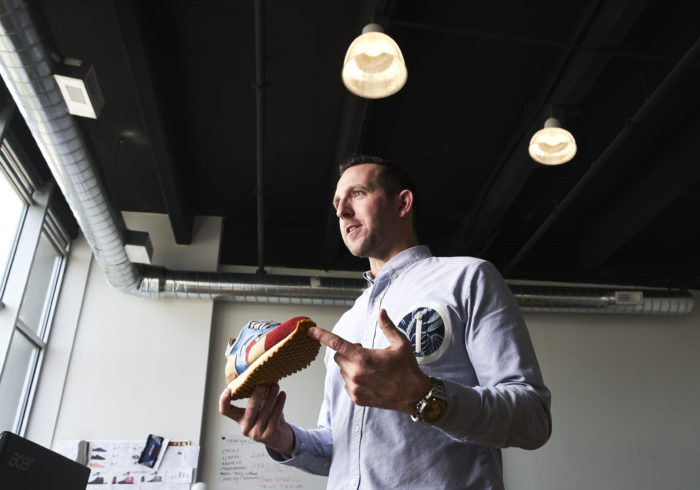
CEO Ryan Babenzien, a Long Island native who worked in the shoe business in California, knew that his startup had to be based in Brooklyn
On this particular summer day, the company’s soft-pink leather women’s Blush Royale sneaker is featured on the homepage of Gwyneth Paltrow’s lifestyle website Goop.com as part of a brand partnership. What’s more, Babenzien says he hears that Gwyneth was wearing the sneakers in a recent photo shoot. On top of that, the $99 Royale Knit sneaker releases today, a variation on Greats’ most popular shoe, the $169 leather Royale. The new Royale Knit–available in red, navy or gray–has a mesh-like fabric upper and a colorful tab in the back.
The combined popularity of Goop and the Royale model suggest that orders are going to be brisk today for the Greats brand, which sells its style-focused sneakers primarily via its website, in the same vein as Everlane and Industry Standard. With no retail middleman, the business touts its ability to produce trendy kicks made of high-quality materials—think Italian leather and Vibram soles—at a more congenial price than brands reliant on brick-and-mortar stores to position their shoes.
Opening a New Destination
Starting Aug. 1, however, the brand will provide a physical destination for loyalists to check out its wares when the company moves its headquarters to N. 10th Street in Williamsburg. There, consumers will be able to make an appointment, try on shoes, and buy them–an example of what Babenzien calls an “immersive Greats experience.” In September, an exclusive partnership with Nordstrom will put Greats sneakers in eight department stores on the West Coast.
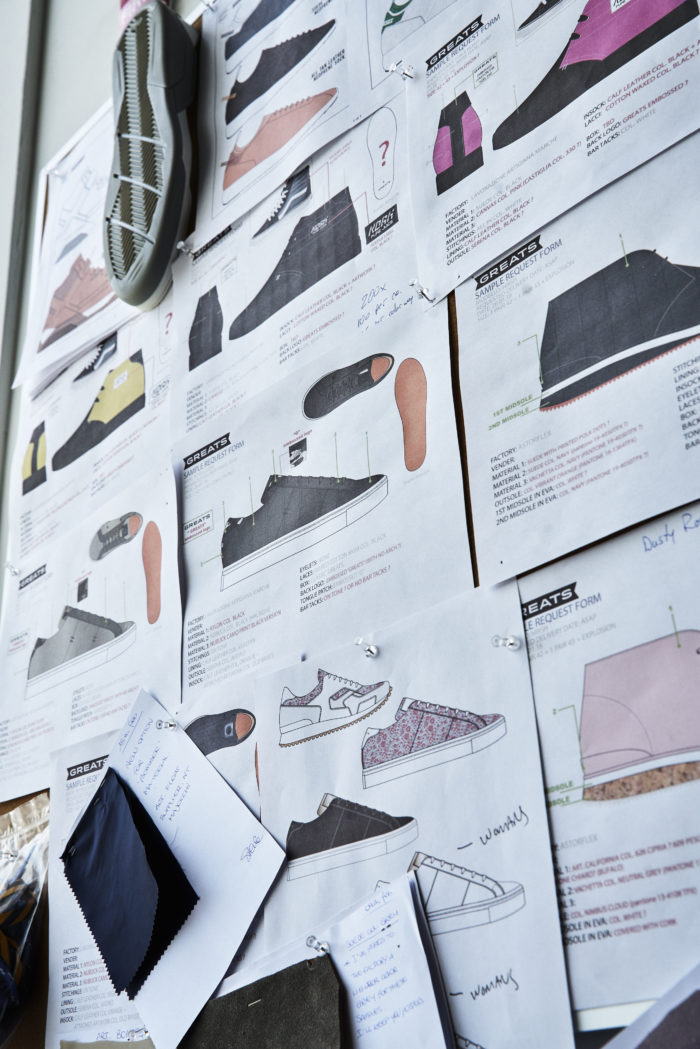
The drawing board at Greats headquarters in Williamsburg
Breaking into a hyper-competitive sneaker market ruled by “incumbents” like Nike and Adidas wasn’t easy, says Babenzien. But he knew what he was getting into, having worked in marketing at brands Puma and K-Swiss. That experience, he said, gave him a sense of “what really matters in the sneaker business.”
“Any industry worth disrupting is going to be competitive,” Babenzien says, “or else they’re not worth going into. So we got asked that question a lot: Like, ‘How are you going to do this?’ And very simply, we were like, ‘Well, we think we have a better position in style, we’re closer to the market, we can make a better product–so higher quality–and offer it at a more accessible price, whether it’s $50 competing against $90 in the incumbent land, or $160 competing against $500 in our Italian luxuries.’”
Greats now frequently sells out of its stock, judging by availability on its website. Some sizes of the $179 women’s Blush Royale, for example, are labeled a “preorder” that will ship later in the month. Some sizes have as few as “just five left” or are sold out completely.
The Three Basic Challenges
Reaching this point, though, meant overcoming three specific small-business obstacles: getting the shoes in front of the customer without, say, a Foot Locker to put them in the window and offer try-ons (customer acquisition); catching up with demand (inventory management); and designing, manufacturing, and marketing on a smaller scale.
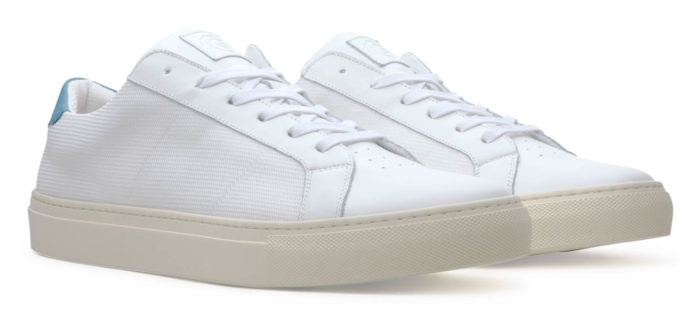
The Royale, shown here in the Vintage nylon model, is the company’s best-selling line
Much of what drives the sneaker business model is mass production. “Minimums going into the footwear industry are fairly high, so you can’t just walk in and say, ‘I want to make 100 pairs and try this out,’” Babenzien says. “We had, fortunately, some very good relationships going in with a very clear vision of what we felt our business was going to look like and were able to partner with some production facilities that understood our vision. But it certainly isn’t the norm for production, not just in footwear. Production, manufacturing–they want you to take as much as you can, in the shortest amount of time.”
Yet the game may be changing. “I actually think the world altogether is moving in a different direction,” says Babenzien, toward smaller batches and better quality. “I wouldn’t say I’ve cracked the code on what that’s going to look like, but I don’t think the days of just a million pairs out of the door–I don’t think that’s happening for future brands.”
What isn’t a priority for the brand is reinventing the wheel–or the shoe, as it were. The brand currently sells just 11 silhouettes, which it describes as “timeless” and “iconic sneaker silhouettes that have defined style across generations.” Translation: Some of these shoes might look … familiar. But that’s where the brand’s name comes from.
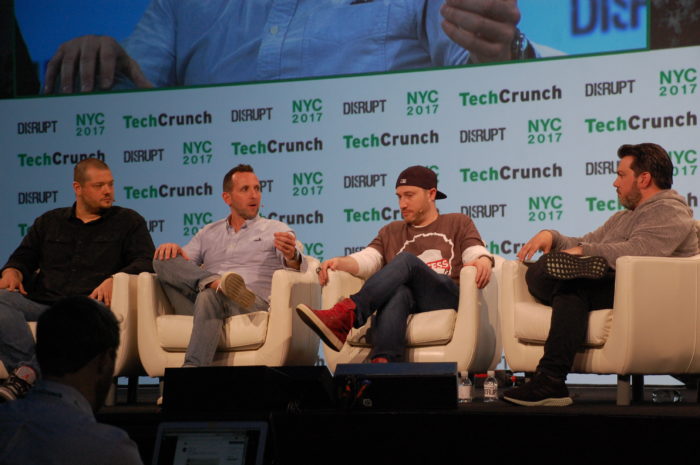
In May, Greats CEO Babenzien, second from left, appeared on a panel at the TechCrunch Disrupt conference with two other footware-industry disrupters, retailers John McPheters of Stadium Goods, far left, and Josh Luber of StockX, in cap (Photo by Steve Koepp)
“We’re not interested in inventing a new silhouette, because we really don’t think many people have been able to create one in the last 40 years,” Babenzien says. “If you look at those incumbent brands, they’re still selling 40-year-old legacy sneakers in massive quantities. So we felt we could innovate around those silhouettes.”
That not-too-hot, not-too-cold, just-right balance gels with the company’s goals, which Babenzien details as: “Continue on our path of success” and “How do we continue to position our brand in efficient ways, acquire customers, get in front of more customers?”
The Marketing Secrets
Sneaker collaborations have gone a long way in doing that. Greats has created special editions with Oakland Raiders running back Marshawn Lynch, Japanese boutique chain United Arrows, and street-style fashion consultant Nick Wooster.
“There’s some things that we do very, very well that I think will give us a long-term relevancy score, and kind of stay in that middle cool area without flaming out,” Babenzien says. “I think too much hype can kill things really, really quickly, and we’re definitely not interested in that.”
Press and social media have also played a major role in catching the customer’s eye. To wit: Ryan Seacrest regularly wears the brand; Greats gave President Barack Obama a custom pair of its Royale sneakers in January, which he was gamely photographed with; and a coterie of aspirational models, style bloggers, and influencers sport the sneakers on Instagram and in photos filed under “Style Inspo” on Greats’ blog. On the women’s side, Greats has paired up with Caila Quinn, a finalist on season 20 of ABC’s The Bachelor, who, in an Instagram post, perches on a café barstool with an iced coffee wearing–you guessed it–the Blush Royale.
“We try to work with people who want to wear our product, not who can we pay money to,” Babenzien says. “That was one thing that always bothered me working at the bigger brands. Like, they would just pay people to do stuff, and you can do that, and there is some value in it; it’s just not as valued as if somebody said, ‘I wear your shit already, so I’ll do it no matter what.’”
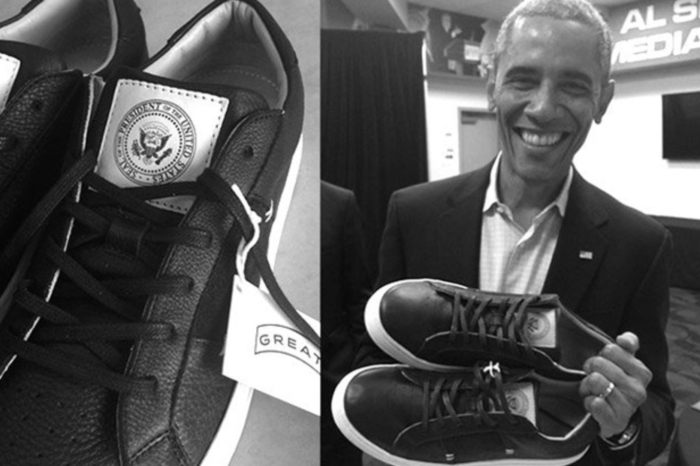
The company gave President Obama a custom-made pair of its Royale model with a Presidential seal
In part, Greats has built its business on selling millennial consumers not just fashionable sneakers, but the Brooklyn lifestyle, as evidenced by its 105,000-follower Instagram account featuring quintessential borough landmarks like St. Ann’s Warehouse and the Brooklyn Bridge. “We didn’t actually post a sneaker for the first two months on Instagram,” Babenzien says. “And it was less about ‘strategic’ as we didn’t actually have one yet. So we were posting the lifestyle component of what Greats is about and what’s interesting to us, and how we think about design, and we managed to keep that. It’s part of our DNA. It’s part of the reason we’re in Brooklyn, which is a community of artists and musicians and food people and style people.”
Building Up in Brooklyn
Babenzien has far-reaching dreams for Greats’ impact on Brooklyn. He hopes to bring some of the company’s manufacturing, which is centered mostly in Italy, to its home borough. “We believe we can build a production facility in Brooklyn, where we can make sneakers here,” he says. “Really engage in the community, where we’re hiring local talent that will learn design, development, manufacturing, retailing, marketing, and hopefully kind of engage the youth of the Brooklyn community, where we create a program with schools. They would start at 15, and upon graduation, they can just stay and work if they’re not going on to college, which I imagine a lot of inner-city kids don’t. So we feel there’s a bigger opportunity to give back to Brooklyn as a whole.”
It sounds similar to what the Shinola brand is doing in Detroit. Babenzien concurs. “We think we can be that beacon of Brooklyn,” he says. “That clearly has marketing value, it certainly does. That’s not why we would do it, but we understand that it could bring more investment in Brooklyn and more production opportunity in Brooklyn, and ultimately support the economy.”